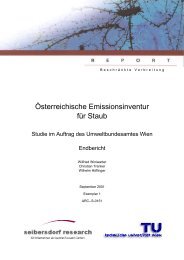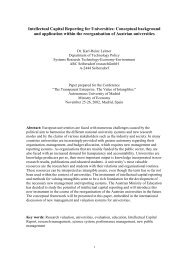ALPMON FINAL REPORT - ARC systems research
ALPMON FINAL REPORT - ARC systems research
ALPMON FINAL REPORT - ARC systems research
Create successful ePaper yourself
Turn your PDF publications into a flip-book with our unique Google optimized e-Paper software.
Contract ENV4-CT96-0359 <strong>ALPMON</strong><br />
density, management type and intensity, erosion zones, avalanche risk zones, etc.. This should allow the<br />
identification of developments which might lead to disastrous events. The quantification of the risk<br />
potential caused by the observed trends of decreasing protection function of forests in the alpine<br />
environment should allow the administration to take preventive measures.<br />
The <strong>research</strong> results should be used as input parameters for models, which simulate the effects of global<br />
change on alpine eco<strong>systems</strong>. Based on the results the development of scenarios should be done, taking<br />
into account the differing predictions of models or, especially for the socio-economic sector, follow on<br />
effects of EU legal frameworks and especially the subsidies policy (Agenda 2000, etc.).<br />
Taking into account the upper considerations a technical/methodological development on RS data<br />
handling and preparation as well as the resulting improvements for thematic evaluation chains can be<br />
observed these days. The final products to be offered in the future to the customers are multi-criterial<br />
evaluation procedures, able to contribute to decision finding on management level or really to propose a<br />
rank of possible alternatives for specific problems. Such multi-criterial evaluation <strong>systems</strong> should focus on<br />
the natural environment but also on socio-economic developments and their follow on effects on the<br />
functionality of alpine eco<strong>systems</strong>.<br />
3.5 Exploitation<br />
The techniques and methods developed within <strong>ALPMON</strong> are of very significant interest to all<br />
customers. As all customers are environmental oriented organisations the main exploitation plans are<br />
connected to possibilities to improve environmental conditions in the Alps. Internal priorities for<br />
utilisation of the results are strong since the methods gave all partners tools to collect essential<br />
information on the alpine environment that will be of increasing importance in the future. The expertise<br />
and knowledge gained will secure the partners national role in <strong>research</strong>ing and monitoring the<br />
environment.<br />
The result of this investigation were and still will be printed in <strong>research</strong> papers. It follows that<br />
publication of results to the scientific community was a major goal. Additionally, subtask, interim, and<br />
final reports are presented on the <strong>ALPMON</strong> homepage and may be downloaded from there. The<br />
results also were presented in international congresses and symposiums.<br />
The software produced in this investigation was made available for every partner and the customers.<br />
The established databases of <strong>ALPMON</strong> were given to the customers. The customers benefit from the<br />
methods and guidelines developed in this project. These methods can now be used for practical<br />
planning tasks.<br />
Another output of the project are maps illustrating the classes and environmental parameters for larger<br />
areas. These maps may be provided on request for administration organisations as a base for<br />
decisions.<br />
ALU<br />
There was very much interest shown in the results of the application 'remote sensing and tourism' by<br />
German tourist associations and nature park administrations. This led to the planning of new tourism<br />
projects with new partners where the results of the project will be enlarged and put up to practice.<br />
One result of <strong>ALPMON</strong> is a virtual fly-through showing a combination of the different image data used<br />
for the Engadine test site draped on a digital elevation model (done with ERDAS Imagine). This flythrough<br />
will be passed on to the National Park Administration for further use in their public relations<br />
activities.<br />
JR<br />
One main output of the project was the detailed classification of forest parameters with special respect<br />
to the alpine protection forest. Methodologies have been developed and applied to derive these<br />
parameters from high resolution satellite images. These results will be brought into projects which are<br />
concerned with the classification and monitoring of protection forests in Austria. In this respect<br />
Joanneum Research is negotiating with the Austrian Ministry of Agriculture as well as with the<br />
Government of the Province of Carinthia. Among others, an INTEREG project on this topic is<br />
envisaged together with Carinthia and Slovenia.<br />
Furthermore, Joanneum Research is specialising in supporting the assessment of avalanche risks<br />
from different points of view. Negotiation with the Austrian Ministry of Agriculture are in the final phase<br />
concerning a project which shall investigate the use of laser scanner data for deriving a very detailed<br />
JR, RSDE, ALU, LMU, Seibersdorf, WSL 90




